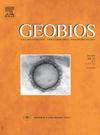森林地区仓鸮(Tyto alba)摄取的微型脊椎动物的实际分类。对化石记录的启示
IF 1.6
4区 地球科学
Q2 PALEONTOLOGY
引用次数: 0
摘要
啮齿类动物是夜间活动的猛禽的常见猎物,它们吞食整个个体,随后将部分消化的残骸以反刍的形式排出。这就产生了可能成为化石记录一部分的骨骼元素的积累。推断哪个捕食者对任何给定的化石微脊椎动物的组合负责,可以评估潜在的偏见,并做出古生态推断。新物种学研究可以对不同环境条件下不同猛禽的特征进行建模。在此基础上,考虑到微脊椎动物化石的分类和解剖学丰度、消化系统腐蚀程度和骨骼残骸的断裂程度,可以推测出微脊椎动物化石组合中涉及的捕食者。然而,到目前为止,还没有对阿根廷西北部的猛禽进行详细的新物种学研究,而南美洲的其他研究主要是在开阔和干旱的环境中进行的。这迫使古生物学研究使用可能不完全相关的类似物。在这里,我们对从谷仓猫头鹰(Tyto alba)生产的现代颗粒中回收的啮齿动物骨骼遗骸(NISP = 7540)进行了实际研究,这些颗粒在Villa Padre Monti (Tucumán,阿根廷)回收,这是一个部分受作物影响的Yungas森林地区。目的是在这些环境条件下表征白僵菌的埋藏痕迹。该组合由至少五种蟋蟀科啮齿动物和各种骨骼元素组成,特别是后颅骨;它具有较高的相对解剖丰度(58.7%)。骨骼断裂的程度很低,尤其是下颌骨和后颅骨。消化腐蚀主要不存在(62.1%),尽管在极端消化类别中发现了一些具有高度消化腐蚀的元素。这些结果通常与其他关于仓鸮的分类学研究相比较,并为这种隐形目的现代积累的已知变异性增加了数据。因此,它们有望对化石动物群的解释产生影响。本文章由计算机程序翻译,如有差异,请以英文原文为准。
Actualistic taphonomy of microvertebrates ingested by the barn owl (Tyto alba) in a forested area. Implications for the fossil record
Rodents are common prey of nocturnal raptor birds, which ingest whole individuals and subsequently expel partially digested remains as regurgitated pellets. This generates accumulations of skeletal elements that may become part of the fossil record. Inferring which predator was responsible of any given fossil microvertebrate assemblage allows assessing potential biases and making paleoecological inferences. Neotaphonomic studies allow modelling the particularities characterizing different raptors under different environmental conditions. Based on them, it is possible to suggest the predator involved in fossil microvertebrate assemblages by considering the taxonomic and anatomical abundance, the degree of digestive corrosion and that of breakage of skeletal remains. Yet, no detailed neotaphonomic studies on raptors had been made so far in NW Argentina, and other studies in South America have been made mainly in open and arid environments. This has forced paleontological studies to use analogues that might not be fully relevant. Here we present an actualistic study on rodent skeletal remains (NISP = 7540) recovered from modern pellets produced by the barn owl (Tyto alba), recovered at Villa Padre Monti (Tucumán, Argentina), a Yungas forest area partially affected by the presence of crops. The aim is to characterize the taphonomic traces of T. alba under these environmental conditions. The assemblage is composed of at least five species of Cricetidae rodents and a varied representation of skeletal elements, especially of the post-cranium; it has a high relative anatomical abundance (58.7%). Skeletal breakage levels are low, especially in the mandibles and post-cranium. Digestive corrosion is predominantly absent (62.1%) to light, although some elements with high degrees of digestive corrosion were found, even in the extreme digestion category. These results generally compare well with other taphonomic studies on the barn owl, and add data to the known variability of modern accumulations by this Strigiformes. They are thus expected to have an impact on the interpretations of fossil faunas.
求助全文
通过发布文献求助,成功后即可免费获取论文全文。
去求助
来源期刊

Geobios
地学-古生物学
CiteScore
3.30
自引率
6.20%
发文量
28
审稿时长
6-12 weeks
期刊介绍:
Geobios publishes bimonthly in English original peer-reviewed articles of international interest in any area of paleontology, paleobiology, paleoecology, paleobiogeography, (bio)stratigraphy and biogeochemistry. All taxonomic groups are treated, including microfossils, invertebrates, plants, vertebrates and ichnofossils.
Geobios welcomes descriptive papers based on original material (e.g. large Systematic Paleontology works), as well as more analytically and/or methodologically oriented papers, provided they offer strong and significant biochronological/biostratigraphical, paleobiogeographical, paleobiological and/or phylogenetic new insights and perspectices. A high priority level is given to synchronic and/or diachronic studies based on multi- or inter-disciplinary approaches mixing various fields of Earth and Life Sciences. Works based on extant data are also considered, provided they offer significant insights into geological-time studies.
 求助内容:
求助内容: 应助结果提醒方式:
应助结果提醒方式:


